-
Car Reviews
- Car News
-
Car Comparisons
Latest comparisons
- Chasing Deals
With a new engine option, and a flash new interior, it’s clear Ford is aiming higher with this new Everest, but has it been able to shake the nature of its crude ute-based underpinnings?
As one of the most popular utes in the country for some time now, it comes as little surprise to hear that the new Ford Ranger is selling like hotcakes – but will it be the same for the new Everest, the Ranger’s more refined wagon-bodied cousin?
Possibly – or not. And that’s not because Ford’s new Everest isn’t a fantastic full-size SUV, but because Australia’s infatuation with utes continues to trump all else on the scene. But the Everest certainly has a chance to eclipse the sales of the previous-generation model.
Just like its Ranger counterpart, the Everest recently underwent a massive upgrade that saw big changes in the power department as well as an impressive new interior, plus substantial revisions to the old model’s platform.
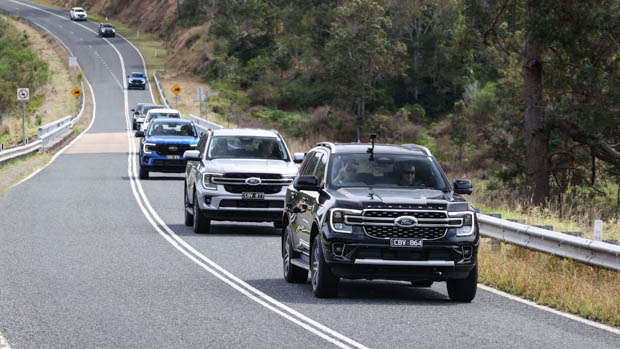
This new generation sees the older 3.2-litre turbocharged five-cylinder diesel engine make way for a torque-heavy new 3.0-litre turbo diesel V6. Fans of Ford’s biturbo 2.0-litre diesel engine will be happy to hear that it remains an option in the new Everest, although slightly down on power from its last iteration.
The exterior aesthetic has also undergone some serious changes, featuring a more squared-off, and imposing stance. Like the Ranger, the Everest now gets Ford’s iconic C-clamp headlight assembly up front, which houses a pair of fancy matrix LED headlights in the range-topping model.
This imposing visual theme continues around the side of the SUV where it gets a strong shoulder line and the same goes with the rear of the SUV with its squared-off light bar.
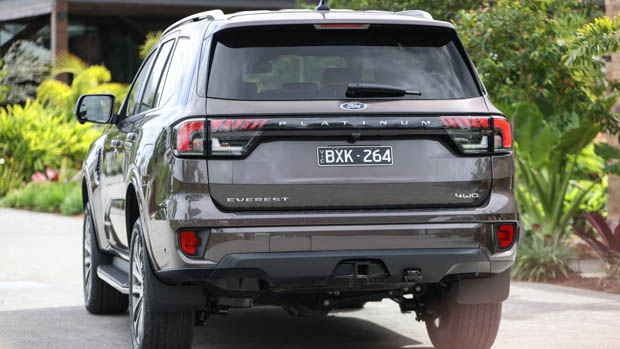
In Australia, Ford offers the Everest in four variants, with pricing ranging from $58,030 to $83,789. As always, the pricing scheme isn’t overly linear with 4×2 and 4×4 variants offered in some parts of the range.
The entry point to the range is the Ambiente, which costs $58,030 in 2×4 form, and jumps to $63,280 as a 4×4. Next up is the Trend, which starts at $65,695 for a 2×4, and tops out at $70,945 for a 4×4. As standard, these two lower level variants are offered exclusively with the 2.0-litre bi-turbo diesel engine.
Offered as standard with a full-time 4WD system and the larger 3.0-litre V6 engine is the Sport, which starts at $74,935. Lastly, the jewel in Ford’s Everest crown is the Platinum, which also gets the V6 as standard, and is only offered with a 4WD system. This range-topping Platinum starts at $83,789, but comes with an impressive amount of extra kit.
So with a new face, a new power plant, and a fancy plethora of tech on the inside, has Ford done enough to overcome the shortcomings of the ute-based SUV segment that we’ve seen in the past?
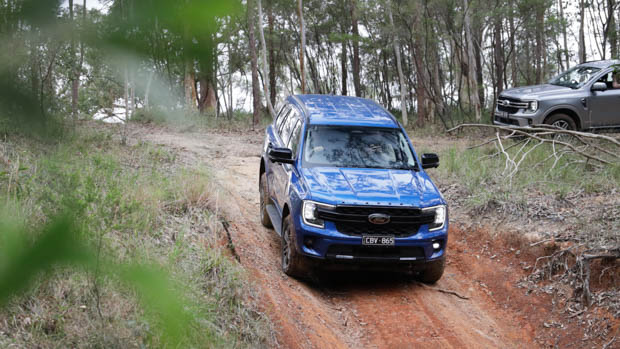
To address the elephant in the room: more refined though it may be, there’s still no avoiding that the Everest sits on a ute chassis – but the new version is a notably more comfortable and isolating car than before
As with the previous Everest, the wagon is suspended by coil springs at all four corners rather than rear leaf springs, as in the Ranger.
But even with the car-like suspension, the Everest isn’t out of the woods yet. There appears to be a marked difference in ride quality between the 2.0-litre and 3.0-litre vehicles, with the more refined ride coming from the higher spec models – despite significantly larger wheels on the Platinum.
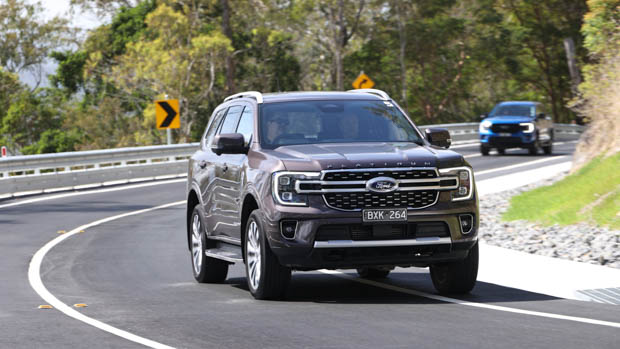
This is not to say that the Ambiente and Trend models were particularly uncomfortable, but the rain-damaged rural Queensland roads demonstrated that they have a more curt ride at the rear.
There’s little road feel translated through the steering, and while the rack isn’t particularly quick, it’s weighted heavily enough to give confidence on a brisk drive. It’s also worth noting the Everest’s tendency to understeer when fitted with the larger all-terrain tyres that are part of the off-road pack – but that characteristic is normal for off-road rubber.
The choice of two engines is maintained for the new Everest, but with a much more premium high-end motor, and it’s clearer than ever which engine serves which purpose.
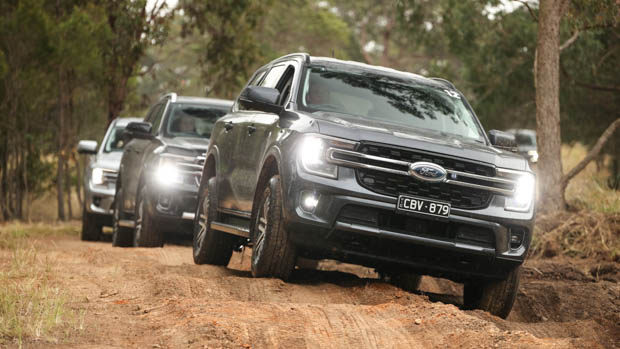
You’ll find the 2.0-litre biturbo diesel engine occupying the cheaper end of the Everest range for a number of reasons. With 154kW and 500Nm on tap, this 2.0-litre is still a heavy hitter in the scheme of small displacement engines, but it isn’t as refined, aurally, as the bigger lump.
With 184kW and 600Nm of torque on tap, the bigger 3.0-litre V6 engine doesn’t sound like much extra chop over the bi-turbo on a pure numbers basis, but it really is. Despite the fact that it uses a large single turbo as opposed to the two strapped to the smaller engine, almost no power lag is evident.
It’s not only torque delivery where this larger engine shines, as it also feels a lot more refined. Ian Foston, Ford’s T6 platform chief engineer, mentioned at the launch that a lot of work went into making sure that the engines were quieter, with minimal mechanical noise and rattle making it into the cabin. I’d say that this is a lot more evident in the V6 over the four-banger.
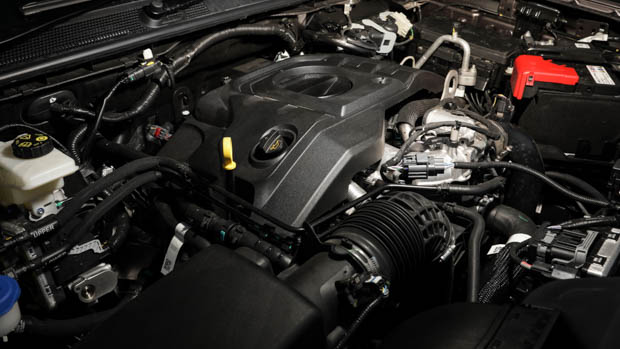
The Everest comes standard with the ten-speed torque converter automatic transmission previously fitted to the 2.0-litre only. The auto feels more refined in this iteration. It still has the tendency to be quite busy when paired with the 2.0-litre, but the torque-heavy V6 seems to calm it down.
It should come as little surprise to hear that 80 per cent of Australia Everest buyers are looking to haul with the SUV, as they have opted for the $1700 tow pack. Speaking of towing, 3.5-tonnes is the maximum capacity across the range, which includes the two-wheel drive variants as well – an upgrade over the old vehicle’s rating.
On the safety front, Ford’s biggest SUV comes crammed with all the advanced safety technology that you’d expect as standard. This includes adaptive cruise control, lane keep assist, and blind spot assist with rear cross alert, just to name a few.
Ford’s assist systems are some of the best in the business from a tuning perspective, and the Everest is no different. I’m especially a fan of the lane-keep assist that keeps the vehicle in the centre of the lane without applying overly aggressive steering inputs as other vehicles are known to do.
Impressive is one word that I’d use to describe the interior that comes standard across the whole Everest range, and the real highlight is the new portrait-orientated touchscreen.
Measuring in at 10.1-inches in the Ambiente, and 12.4-inches in the Trend, Sport and Platinum,, the huge screen runs Ford’s new Sync 4 software – one of the more intuitive systems I’ve come across.
Here, the Everest is substantially more sophisticated than rivals like the Isuzu MU-X or even the Toyota Prado. The familiar iPad-style layout means simple menu navigation, and the basic games section is going to be a hit with bored passengers. As standard, this infotainment system gets both wireless Apple Carplay and Android Auto connectivity, and the top two variants add a wireless charging pad.
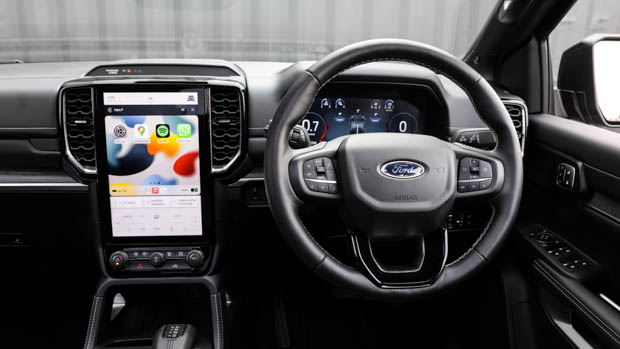
The level cabin appointment is impressive across the range, with a surprising proportion of soft-touch materials within the driver’s reach. Every Everest variant above the cloth-trimmed entry-level Ambiente gets leather upholstery, while the flagship Platinum does even better with nappa leather as standard.
Something that took a little getting used to was the gear selector, which features the manual shifting buttons on the side, where an unlock button usually is. I’m sure this is something that owners will get used to in a short amount of time, but was an annoyance during the first drive.
When it comes to space, there’s plenty of it across the front two rows, with the Everest being wide enough to accommodate three adults across the second row. I was a little surprised at the lack of room in the third row of seating, but the roof-mounted aircon vents do a great job of mitigating the claustrophobic feeling. It also helps that the second row of seats is on a slider, and can be moved forward for extra rear leg room.
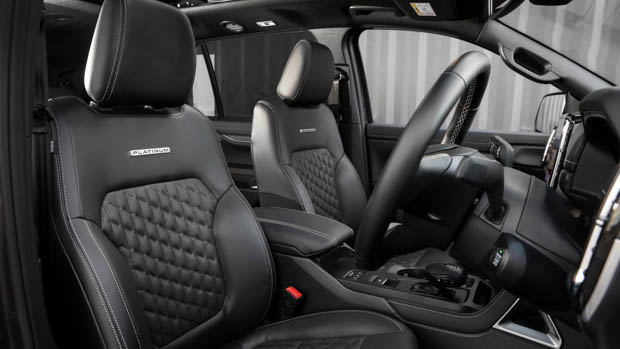
As you’d expect, fuel consumption varies between the two models, with the smaller engine being the more economical choice across the board.
At the lowest end of the spectrum are the 2.0-litre 2×4 models which average 7.1L/100km. This steps up to 7.2L/100km for the 2.0-litre 4×4 models, and the average consumption in the two V6 variants sits at 8.5L/100km. Though we weren’t able to spend an extended period of time in each variant as we swapped throughout the day, these figures look pretty spot on.
When it comes to servicing, Ford offers capped price general servicing over the first four years or 60,000km of ownership. According to the brand’s website, the most that any owner will pay for one service will be $329 throughout this time period. Ford also offers a five year/unlimited KM warranty across the whole range.
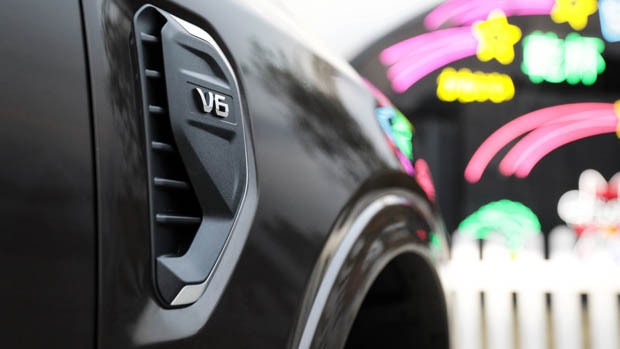
All up, an Everest owner can expect to pay $1,316 for the first four years of servicing the SUV, which is quite a bit cheaper than any of its ute-based rivals. Mitsubishi Pajero Sport owners can expect to pay $1996 over the same four-year period, and the Isuzu MU-X is exactly the same. The Toyota Fortuner comes in at $1040 with capped price servicing over three years, or 60,000km.
We’re genuinely impressed with the new Ford Everest. It feels like it has taken a significant step forward from other ute-platform rivals like the Mitsubishi Pajero Sport and Isuzu MU-X, further toward four-wheel drive wagons that are typically regarded as more premium, like the Toyota Land Cruiser Prado.
If buyers are just looking for a comfortable SUV that fits the whole family, and will happily tow the boat, then I see no reason to skip the entry-level Everest Ambiente 2WD. But should you splurge on a V6? Definitely, if you want a premium-grade touring four-wheel drive at a price that won’t break the bank, especially when compared to a Prado.
For some time now, there has been little refinement in the ute-based SUV segment, and I’d argue that the new Ford Everest is a breath of fresh air here. There’s no getting past the ute underpinnings, but the new engine, infotainment system and cabin really prove a strong point for the Ford being the best in class here.
Variant tested Platinum
Key specs (as tested)
About Chasing cars
Chasing Cars reviews are 100% independent.
Because we are powered by Budget Direct Insurance, we don’t receive advertising or sales revenue from car manufacturers.
We’re truly independent – giving you Australia’s best car reviews.
The estimate provided does not take into account your personal circumstances but is intended to give a general indication of the cost of insurance, in order to obtain a complete quote, please visit www.budgetdirect.com.au. Estimate includes 15%^ online discount.
^Conditions Apply
Budget Direct Insurance arranged by Auto & General Services Pty Ltd ACN 003 617 909(AGS) AFSL 241 411, for and on behalf of the insurer, Auto & General Insurance Company Limited(ABN 42 111 586 353, AFSL 285 571).Because we don’t know your financial needs, we can’t advise you if this insurance will suit you. You should consider your needs and the Product Disclosure Statement before making a decision to buy insurance. Terms and conditions apply.
Indicative quote based on assumptions including postcode , 40 year old male with no offences, licence suspensions or claims in the last 5 years, a NCD Rating 1 and no younger drivers listed. White car, driven up to 10,000kms a year, unfinanced, with no modifications, factory options and/or non-standard accessories, private use only and garaged at night.
^Online Discounts Terms & Conditions
1. Discounts apply to the premium paid for a new Budget Direct Gold Comprehensive Car Insurance, Third Party Property Only or Third Party Property, Fire & Theft Insurance policy initiated online on or after 29 March 2017. Discounts do not apply to optional Roadside Assistance.
2. Discounts do not apply to any renewal offer of insurance.
3. Discounts only apply to the insurance portion of the premium. Discounts are applied before government charges, taxes, levies and fees, including instalment processing fees (as applicable). The full extent of discounts may therefore be impacted.
4. We reserve the right to change the offer without notice.